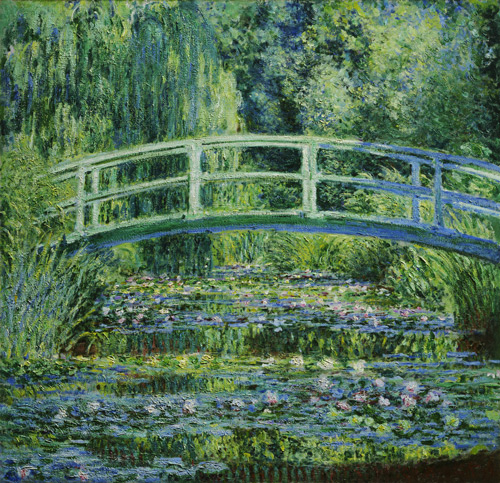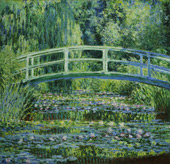Water Lilies and Japanese Bridge 1899 By Claude Monet
Water Lilies and Japanese Bridge 1899 By Claude Monet
Even among famous Impressionist paintings, Claude Monet's Water Lilies and Japanese Bridge 1899 is one of the most recognizable images ever. The vertical format makes it particularly unusual among Claude Monet's famous paintings, allowing him to share his magnificent water lilies, guiding the viewer through his garden delights.
What Inspired Water Lilies by Monet?
In 1883, Monet moved to Giverny, a small commune in Northern France. Monet purchased a beautiful home just outside the town where he planned to transform a small pond on the neighboring patch of land into Asian-inspired gardens. After diverting water from the Epte River to expand the pond, Monet filled his watery wonderland full of flowers, willow trees, bushes, and reeds. Of course, water lilies were also a key feature. The artist's garden at Giverny was installed without the initial intention of creating art. In fact, in 1924, Monet remarked, “I grew them without thinking of painting them.” Monet's Gardens at Giverny later inspired him to paint some of his most famous artwork.
In 1935 the Japanese wooden bridge became a feature, specifically “for the pleasure of the eye and motifs to paint,” the scene was set for Monet’s enduring stimulus. He described how suddenly he felt an almost religious “revelation of the enchantment of my pond.” Claude Monet picked up his artist’s palette; the rest is history. In 1895 Monet started his paintings of the Gardens in Giverny. He remained transfixed by his beautiful pond, bridge, and water lilies for the rest of his life.
What is the Message of The Water Lilies by Claude Monet?
Even among the many examples of Claude Monet's famous artworks, the Water Lilies and Japanese Bridge paintings are particularly remarkable. The message in Monet's paintings is clear; it is simply his intensely detailed observation and appreciation of nature. His lush and luminous brushwork immerses the viewer in the green canopy of the garden. The blue bridge provides pictorial relief, suspended towards the top of the canvas. It almost serves as a horizon, giving perspective to a composition overrun with riots of green foliage.
Indeed, the greenery appears with controlled vertical dabs of paint, creating an upwards motion. Contrastingly, the water lilies emerge through broader horizontal strokes, providing contrast and interest to the piece. Cool green and blue tones dominate the composition. However, these cooler tones balance with the interspersion of the brighter pink, white, and yellow water lilies. These flowers float on the pond's surface in a complex, interlocking pattern. Occasional glimpses of watery reflections are just possible amidst the foliage.
As well as balancing the colors and tones, the waterlilies provide a sense of perspective. The flowers gradually get smaller as the perspective lines join underneath the bridge.
What is the meaning of Monet's Water Lilies and Japanese Bridge painting?
Water Lilies and Japanese Bridge is a prime example of Claude Monet's Impressionism artwork. His paintings evidence a growing fascination with Japanese art and culture. The message and meaning of this oil painting reside purely in Monet’s meditative act of observation. Monet's painting of a bridge over water lilies also indicates his admiration of Japanese art combined with modern French Impressionist techniques. Claude Monet's oil paintings mix a light, bright, impressionist color palette and loose brushwork with a deeply controlled and thoughtful Japanese style. Although the artist rarely left Europe and never traveled to Japan, Claude Monet's artworks frequently incorporate Japanese motifs.
As well as Monet's Japanese footbridge paintings, he also introduced stylized landscapes into portrait paintings like Madame Monet en Costume Japonais 1876. Monet also surrounded his rooms at home with Japanese woodblock prints, and he owned over 230 Japanese engravings by the end of his life.
Impression Artwork "en plein air"
Notwithstanding the inspiration of Japanese art, Claude Monet was committed to painting “en Plein air.” He painted outside in his garden and the surrounding countryside whenever the weather permitted, sometimes working on many canvases on the same day. This enabled him to make the most of particular light effects, repeatedly returning to views and motifs. Monet's technique of capturing ever-shifting atmospheric conditions in pictorial form is a characteristic feature of the Impressionist art movement.
How much is Claude Monet’s Water Lilies Painting worth?
Claude Monet's paintings are some of the most expensive artworks in the world. For instance, in 2019, Mueles or Haystacks 1891 became the most expensive impressionist artwork ever sold. It notched up a staggering $110.7 million at auction. Water Lilies and Japanese Bridge 1899 currently hangs in the National Gallery of Art in Washington. It was gifted to the Museum by Victoria Nebeker Coberly in memory of her son, John Mudd. It has never been officially sold on the open market. Consequently, and rarely for Claude Monet's artwork, the value can only be surmised, but a value of between $100 million to $150 million is not unrealistic.
How Many Paintings are there of Water Lilies and Japanese Bridge?
Water Lilies and Japanese Bridge is one of a series of twelve paintings, all painted in 1899. They all present views of the light-dappled pond, water lilies, and overarching footbridge. The concept of repeatedly returning to the same views, with changing seasons and weather conditions, is common in famous Monet's paintings. For instance, he often returned to painting Haystacks several times. There are also many versions of Monet's paintings of the River Seine and Charing Cross Bridge in London.
Other famous impressionists, Camille Pissarro, for example, painted multiple views of the Boulevard Montmartre in Paris at various times of day and weather conditions. Indeed, it is likely that Monet’s pioneering approach significantly influenced Pissarro’s artwork. Monet's Water Lily series was first exhibited in 1900 at the famous Durand-Ruel Gallery in Paris.
Are Water Lilies by Monet Impressionist Artworks?
Impressionist oil paintings utilize small yet visible brushstrokes with an open composition and an emphasis on light. The name of the style derives from another Claude Monet oil painting, Impression Sunrise 1872. While elements of Impressionism appear in Monet’s Water Lilies and Japanese Bridge, the oil painting composition remains relatively closed. There are no open spaces of expansive vistas for the eye to drift over. In this way, the painting references the concept of medieval closed gardens, translated in Latin as hortus conclusus. Monet’s deeply meditative approach also foreshadows the Symbolism art movement of a dreamlike contemplative atmosphere with art.
Fittingly, the water lily series later inspired Symbolist art, which sought to represent absolute truths instead of a strict realist figurative approach. Despite this, while varying inspirations are evident in Monet’s Water Lilies, ranging from Japonisme to Impressionism, Symbolism, and Medieval art, it remains a masterpiece of impressionist artwork and one of the most famous impressionist paintings ever.
Oil paintings reproductions of Water Lilies by Monet are for sale, along with 30,000+ replica paintings by famous impressionist artists Henri Rousseau, Childe Hassam, Paul Cezanne, and Paul Gauguin. Monet's Water Lilies and Japanese Bridge is one of our most Popular Paintings. Buy replica art 100% hand painted by one of our resident professional artists. We have been creating replica paintings since 1996. Our Money Back Guarantee covers standard catalog paintings; wherever you are, INTERNATIONAL SHIPPING IS FREE
We offer a 100% money back guarantee or replacement service. If for any reason you are dissatisfied with your painting please contact us within 7 days of receipt, advising the reason you are unhappy and we will provide you with all the information you need for its return or replacement.
We ship free to anywhere in the world via FedEx or DHL expedited service with online tracking.
Your painting will be shipped rolled in strong plastic tubing, ready for stretching and/or framing locally. This is the conventional method of transporting hand-painted oil on canvas. Learn more about how your painting is shipped.
We are able to offer a framing service intercontinental U.S. Please contact us if you would like a quotation. Alternatively, should you prefer, we can recommend a framer in your area.
Notes About Your Painting
Please note that replica oil paintings are finished with an additional 10cm (4") of extra canvas on all sides, allowing ample surplus canvas for stretching and framing.
Recently Viewed:
Cannot Find What You Are Looking For?
Reproduction Gallery Information
Customer Service
(Send Us A Message)
Tel: (503) 937 2010
Fax: (503) 937 2011








